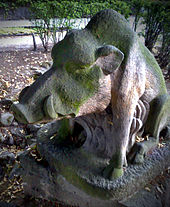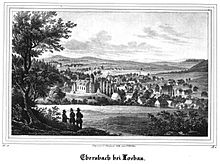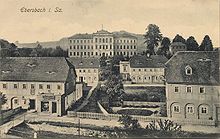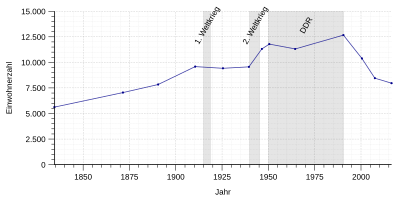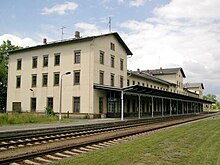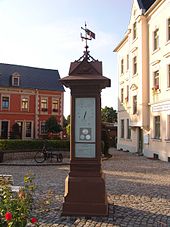Ebersbach / Sa.
|
Ebersbach / Sa.
City of Ebersbach-Neugersdorf
|
||
|---|---|---|
| Coordinates: 51 ° 0 ′ 30 ″ N , 14 ° 35 ′ 0 ″ E | ||
| Height : | 350 m above sea level NHN | |
| Area : | 14.89 km² | |
| Residents : | 7963 (Dec. 31, 2010) | |
| Population density : | 535 inhabitants / km² | |
| Incorporation : | January 1, 2011 | |
| Postal code : | 02730 | |
| Area code : | 03586 | |
|
Location of Ebersbach / Sa. in Saxony |
||
Ebersbach / Sa. ( Ebersbach / Saxony , Upper Sorbian Habrachćicy , Upper Lusatian : Aberschbuch ) is a district of the town of Ebersbach-Neugersdorf in the district of Görlitz . Ebersbach is located in south-east Saxony on the border with the Czech Okres Děčín in northern Bohemia .
geography
Location description
One of the three sources of the Spree is located in Ebersbach . The other two springs are on the Kottmar and Neugersdorf . At the confluence of Bahnhofstrasse / Hauptstrasse ( B 96 ) the source brooks Oberspree and Spree join. The highest elevation in Ebersbach is the Schlechteberg with a height of 485 m above sea level. NHN . It also forms the geographical center of Ebersbach. The city center and the groves are to the west of Schlechteberg. To the north and east, the main road meanders through Niederdorf and Oberdorf to the Golden Lion . To the south-east is the Oberland development area, which was built in the 1970s and 1980s using prefabricated panels . The Spreedorf at the foot of the Schlechteberg stretches from south to west, right on the Czech border near Philippsdorf .
Surroundings
From the observation tower of the Schlechteberg you can see the Kottmar in the east, behind it the Jizera Mountains a little further south , then the Zittau Mountains with the Lausche as the most prominent point. On a clear day you can see the Giant Mountains with the Schneekoppe behind the Jizera Mountains . The Czech foothills of the Lusatian mountains are consistently in the south . Bieleboh and Czorneboh are enthroned in the northwest . To the north you can see the Hohe Dubrau at 307 m and the Monumentberg with its observation tower as the last elevation of the mountainous area in this direction. To the right is the double mountain Löbauer Berg / Schafsberg. The Rotstein with its observation tower and the Königshain Mountains follow further east . It is worth mentioning the former Klunst , once a rock as high as the quarry is now deep. He fell victim to granite mining.
Former city structure
The place Ebersbach was divided into seven districts until 2010:
|
|
history
Ebersbach was founded in the 13th century as a forest hoof village by settlers from western areas. Ebersbach was first mentioned in a document on May 1, 1306, when the Margraves Otto and Woldemar von Brandenburg transferred the place as a soft picture village to the city of Löbau. The first evidence of the Ebersbach church can be found in a document from 1346. In the Hussite War of 1429 the place with the church was completely burned down and kept the nickname Wüstenebersbach for decades . Even sixty years later, in 1486 there were only seven inhabited houses and in a family message from the same year the church ruins can be found. In 1529 Messrs. Ernst and Georg von Schleinitz acquired the place Ebersbach from Rudolf von Gersdorf, under whose patronage the village recovered. Agriculture and handicrafts expanded and construction of a new church began. In 1537 the Kretscham von Ebersbach was mentioned for the first time. In 1550 the church, which was destroyed by the Hussites, was rebuilt and received a bell house. In 1562 the first Protestant pastor came to the village.
Times as a weaving village
In 1570 there were 20 craftsmen in the village, including the first linen weavers . Around 1596, Daniel Rösler's family of forester settled on the edge of the boiler (northwest of the Schlechteberg, around the gas works). In 1597 the wealthy city of Zittau acquired the community from the heirs of Schleinitz. As a result, the economy ( canvas weaving ) flourished , but the village was already badly devastated during the Thirty Years' War . Evangelical exiles from Bohemia and Moravia settled in around 1650 and brought another economic boom. The large number of Christians who had moved in made it necessary to enlarge the church building: in 1682 the nave and tower of the church were built. Around 1700 building activity began throughout the village and around 1729 the looms rattled again in the houses, of which there were 360 in the village. This was the beginning of the canvas wholesale trade, and through its linen industry Ebersbach rose to the third most important industrial location in the Zittau area in 1776. A yarn bleaching facility and a mangle in 1782 opened in the village. In the period 1726–1733 the church was enlarged and consecrated from the end of the 17th century in the Bohemian Baroque style to its present size.
From the early days to the Second World War
In 1839 the community split into two parts: Alt-Ebersbach and the Mundgut community . Alt-Ebersbach was divided into the upper village, the Niederdorf, the Buschmühlenhäuser and the Eibauer side ( Hübelhäuser and a portion of the Löbauer Wiese ). The later called Neu-Ebersbach Mundgutgemeinde included the Hempel, the Haine, the Kesselrand, the Spreedorf , the eighth houses, the Hofeweghäuser and the Schlößchen (area at the district court).
The community library, opened in 1844, was one of the first rural libraries in what was then Germany.
In 1856 Ebersbach became a district court district and in 1859 the oldest land savings bank in Upper Lusatia was established. Since 1873 the place has had a railway connection with connections to Dresden, Zittau, Löbau, Reichenberg and Prague. During this time the village developed more and more into an industrial city. In 1877 the two districts of Altbach and Neuebersbach were reunified. The electricity works on the Haine were built in 1896, the gas works in 1911 and the water works in 1913. On September 5, 1925, the community received city rights . A planned unification of the city with the neighboring Neugersdorf was not carried out.
Post-war development
The population of the city of Ebersbach rose to 12,275 after the Second World War as a result of the reception of refugees and displaced persons . After the founding of the GDR, businesses from the textile industry settled in town again. The new apartment building in prefabricated construction in the Oberland began in 1968/1969 and created a completely new district.
Place name forms
- 1419: Eberßbach, 1433: Ebirspach, 1495: Eberßbach, 1529: Wüst Ebersspach, 1546: Ebersbach, 1768: Ebersbach bey Löbau, 1875: Ebersbach (Altebersbach), 1997: Ebersbach / Saxony
Administrative affiliation
- 1777: Bautzen district, 1843: Löbau district court, 1856: Ebersbach court office , 1875: Löbau district administration , 1952: Löbau district , 1994: Löbau-Zittau district , 2009: Görlitz district
Incorporation
On January 1, 2011, Ebersbach / Sa. merged with the city of Neugersdorf to Ebersbach-Neugersdorf .
Population development
| year | Residents |
|---|---|
| 1777 |
49 possessed men, 29 gardeners, 515 cottagers, 21 devastation |
| 1834 | 5,622 |
| 1871 | 7,049 |
| 1890 | 7,833 |
| 1910 | 9,585 |
| 1925 | 9.419 |
| 1939 | 9,560 |
| 1946 | 11,315 |
| 1950 | 11,789 |
| 1964 | 11,312 |
| 1990 | 12,669 |
| 2000 | 10,382 |
| 2007 | 8,451 |
| 2016 | 7,963 |
politics
coat of arms
The talking coat of arms shows a golden cross river in the green base of the shield, above it in gold a striding black boar with white tusks.
It used to show a boar standing in the water behind a tree with a bird fluttering over it. In earlier times it was interpreted as a raven, probably in connection with the source of the Spree at the nearby Kottmar, which was also called the Rabenbrunnen. The bird was later interpreted as a pigeon. Interpretation: According to old traditions, boars used to roam the village stream and could have served as a template for the image seal, which was then adopted in the city arms.
The city has been using the colors black and gold since 1938.
Town twinning
- Bourg-lès-Valence , France, since 1991
- Ebersbach an der Fils , Germany, since October 5, 1991
- Jiříkov (Georgswalde), Czech Republic
Religions and churches
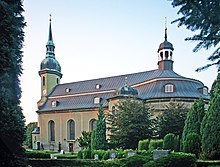
The main religion is Protestantism . In 1525 Ebersbach becomes Protestant and in 1570 receives the first Evangelical Lutheran with Jacob Merwitz from Dresden , who previously worked in Spremberg, now the city of Neusalza-Spremberg . Pastor of the parish. The Protestant church is located directly on the B 96 in the upper part of the city. A little further south-west on the Jeremiasberg is the Catholic Sacred Heart Church, consecrated in 1934.
The Evangelical-Lutheran village church with its original floor plan was built between 1726 and 1733 by adding a centrally designed eastern building mixed with a circle and polygon to an older rectangular long building. It has a wooden barrel vault and a dome. All around there are galleries in 3 storeys with 54 biblical paintings from 1733 depicting the history of salvation as well as a ceiling painting of the wooden barrel that completes the entire room. The church was solemnly consecrated on September 29, 1733.
The splendid prospectus of the organ comes from the instrument that the organ builder Christoph Dressel from Leipzig created in 1685 for the Johanniskirche in Zittau . The cabinet itself was made by the carpenter Heinrich Prescher from Zittau and the carving by Paul Hartmann from Jena. The organ was sold to Ebersbach in 1738. Only the old case remains. The plant itself was changed and renewed several times, most recently replaced in 1994 by a new building by the company Eule from Bautzen. 39 registers are distributed across the main work, upper work and pedal .
economy
Ebersbach is shaped by earlier epochs of weaving and spinning mills . Many preserved half-timbered houses bear witness to this important era. From the 19th century, large industrial complexes for cotton processing were built throughout Upper Lusatia. This branch of industry no longer exists.
As a result of German reunification , almost all the companies that had existed up to that point ceased production, above all the Ebersbach weaving and spinning mill. The textile industry disappeared from the place. The dining house , until 1989 an event location for youth consecrations , company parties, Christmas parties and other major events, housed a supermarket for several years. The building now serves as an event venue again .
The Klinikum Oberlausitzer Bergland gGmbH has internal medicine (including a cardiac catheter laboratory), surgery, gynecology and obstetrics as well as anesthesia and intensive care medicine at its Ebersbach location.
In the place there was a production facility for tea lights of VEB Wittol Lutherstadt Wittenberg .
Other businesses are locksmiths, transport companies, car dealerships, a cinema (which is kept alive through the private commitment of an Ebersbach family), as well as small businesses for arts and crafts and a long-established furniture store. The latter is now called OKA Büromöbelfabrik und Co KG .
According to the will of the city administration, tourism should become the driving economic force. As a first step, Ebersbach presents itself as the city of various fountains and benches .
education
365 students attended the Andert-Oberschule in the 2017/2018 school year .
The Albert Schweitzer special school center can be found in the Oberland district. This was extensively modernized in 2010–2012.
traffic
Ebersbach is an important traffic junction in Upper Lusatia. Already at the time of the Crusades , settlement took place along the trade routes to Bohemia. Ebersbach has the typical image of a forest hoof village - quite narrow, but very elongated. Ebersbach is delimited by a triangular road. The main route today is the federal highway 96 , which meanders north of the Schlechteberg from Zittau in the east to Bautzen in the northwest through Ebersbach. It is crossed east of the Schlechteberg at the "Golden Lion" by the north-south connection L148, the transit route from the Czech Republic to Löbau . From there it goes on to Bautzen ( B 6 ) or Görlitz. The Spreedorfer Straße leads south of the Schlechteberg. It connects the Niederdorf, as well as the city center and the groves of Ebersbach with Neugersdorf. The B 96 and the Reichsstraße (extension of the Spreedorfer Straße) meet on the site of the former parent factory ("Spreeeck"), where the two Spreel courses from the Kottmar and the Spreedorf converge. Spreedorfer Straße begins at the end of Bahnhofstraße, where the border crossing for cars, coaches, cyclists and pedestrians to the Czech Republic is also located. It then leads over the "Blue Wonder" parallel to the railway line and the Spree to Neugersdorf. At the Neugersdorfer Straße intersection, turn right and come to the Ebersbacher “Spreequelle” and the “Spreeborn”.
The Ebersbach (Sachs) station is on the Oberoderwitz – Wilthen railway line . The Ebersbacher Bahnhof is a hub and railway border crossing to the Czech Republic. The Ebersbach – Löbau railway line is only occasionally used for freight traffic; passenger traffic has been suspended since 2001. The cross-border railway line Bakov nad Jizerou – Ebersbach has not been used for passenger traffic since the timetable change in 2010. A cross-border bus line with the number 409 of the Czech transport company BusLine as has since replaced the route. Due to the decline in the textile industry, Ebersbach station no longer has its own freight traffic.
In public transport , Ebersbach is served by the route network of Kraftverkehrsgesellschaft Dreiländereck mbH (KVG), Zittau. This has also replaced the disused rail connection to Löbau. A long-distance cycle path has been created .
Culture and sights
Monuments and memorials
- Memorial at the New Town Hall on Reichsstrasse 1 for the victims of fascism
- Memorial stone at the branch of the grammar school (POS Friedrich Jahn in GDR times ) for the communist resistance fighter Oswald Richter, who was murdered in Dachau concentration camp in 1943 . The stone was removed in 1990 and has been in the school ever since.
Museums
-
Humboldt and Heimatmuseum on the Schlechteberg :
Presentation of the development of Ebersbach, cultural and economic changes, detailed treatment of the cotton spinning mill in Upper Lusatia, photos and documents, original equipment from the old days - Small fire brigade
museum : exhibits (documents and smaller equipment) in two rooms from the time the Ebersbach fire brigade was founded to this day
Sons and daughters of the place
- Carl Wilhelm Hahn (1829–1887), genre and animal painter
- Kurt Bernhardi (1847-1892), educator
- Bruno Röthig (1859–1931), cantor and composer
- Otto Richter (1865–1936), church musician, Kreuzkantor
- Alfred Heinrich (1885–1974), ornithologist and local history researcher
- Paul Sinkwitz (1899–1981), graphic artist and painter
- Werner Andert (1907–1983), local writer
- Herbert Andert (1910-2010), Upper Lusatian dialect poet
- Dietbert Knöfel (* 1936), building materials scientist
- Ivica Račan (1944–2007), Croatian politician
- Bernd-Lutz Lange (* 1944), author and cabaret artist
- Matthias Freude (* 1952), biologist, professor and president of the Brandenburg State Environment Agency
- Theo Nabicht (* 1963), woodwind player and composer
- Ulf Tippelt (* 1963), sports scientist and sports official
- Uwe Daßler (* 1967), swimming athlete
- Antye Greie-Ripatti (* 1969), musician and artist
- Tobias Müller (* 1993), soccer player
literature
- Paul Gottlob: Fragments of a chronicle from Ebersbach. Zittau 1826 ( digitized version )
- Cornelius Gurlitt : Ebersbach. In: Descriptive representation of the older architectural and art monuments of the Kingdom of Saxony. 34. Issue: Official Authority Löbau . CC Meinhold, Dresden 1910, p. 97.
- August Weise: News from the past and present of the Ebersbach community along with insights into the nature of its immediate vicinity . Volume 1, Verlag Clemens, Ebersbach 1888 ( digitized version )
Web links
Individual evidence
- ↑ Upper Lusatian Dictionary: Letter A. Accessed on March 22, 2013 .
- ↑ StBA: Area changes from January 1st to December 31st, 2011
- ↑ Ebersbach / Sa. (Old) in the Digital Historical Directory of Saxony
- ↑ Ebersbach / Sa. - Our city and its coat of arms. (No longer available online.) Archived from the original on April 23, 2011 ; Retrieved July 23, 2010 .
- ↑ Representation of the partner communities ( Memento of the original from April 5, 2013 in the Internet Archive ) Info: The archive link has been inserted automatically and has not yet been checked. Please check the original and archive link according to the instructions and then remove this notice. on the city homepage
- ↑ From the history of the Evangelical Lutheran Church in Ebersbach. Retrieved July 23, 2010 .
- ^ Ulrich Dähnert: Historical organs in Saxony, Leipzig 1983
- ^ Organ building Hermann Eule: Ebersbach / Sachsen, Ev.-luth. Church. (No longer available online.) Archived from the original on October 18, 2011 ; Retrieved July 23, 2010 . Info: The archive link was inserted automatically and has not yet been checked. Please check the original and archive link according to the instructions and then remove this notice.
- ↑ Furniture manufacturer OKA in the Ebersbach-Neugersdorf commercial directory , accessed on December 27, 2016.
- ↑ Brief description of the middle school



